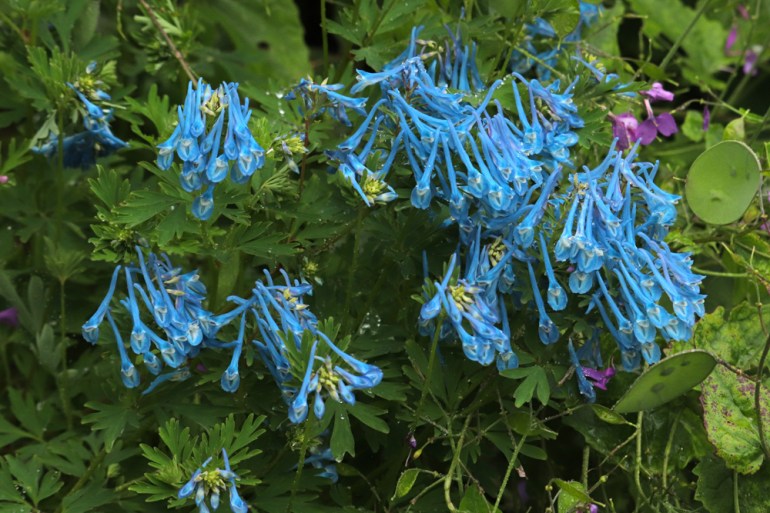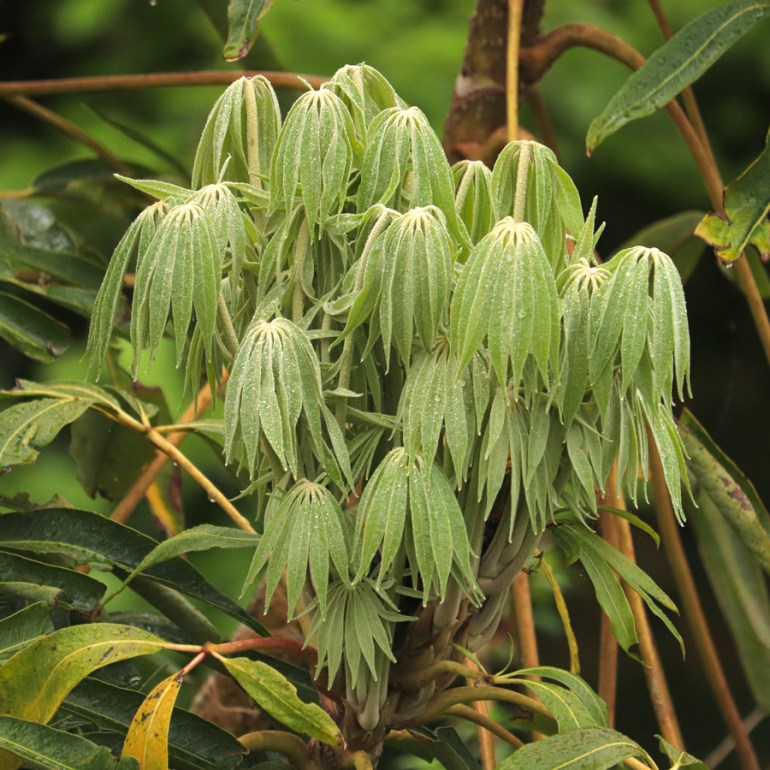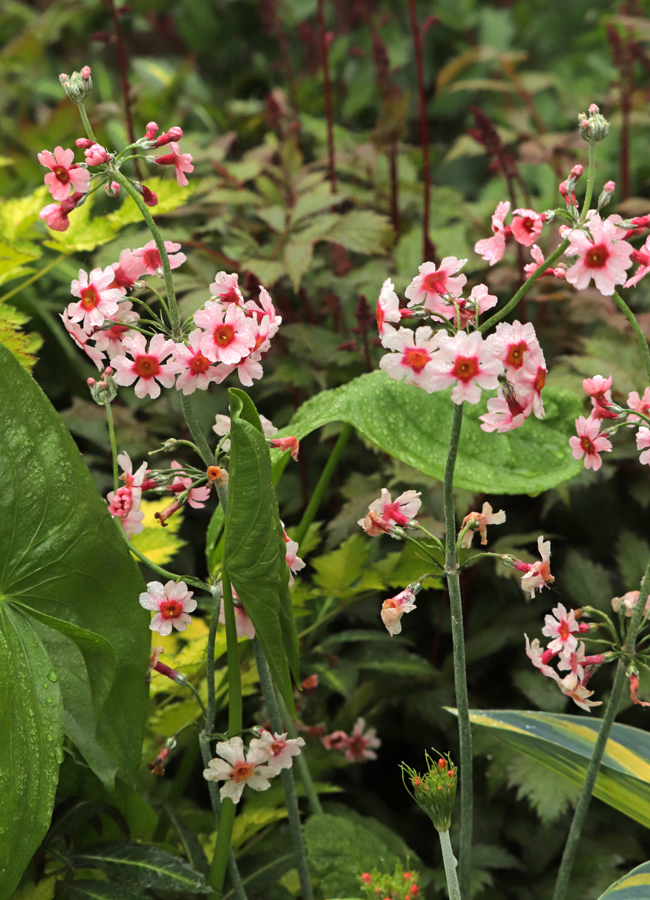The last week has seen an extraordinary spurt of growth in the garden and on the allotment. We’ve had some rain, would have welcomed a bit more, but you get what you get.
I’ve been trying to match the frantic pace of growth with frenetic activity of my own, chopping stuff down, planting, sowing, potting up, potting on, moving things in and out. All of a sudden I need twice as much space as I did a week ago. There is none. When it comes to Friday and thinking about what to put in this weeks six, it’s always the plants that win out. The other stuff seems less important, perhaps more revealing, and not in a good way.
But which six plants. Well this six. It could have been a different six and most of them will be over by next week. You won’t get to see Polygonatum verticillatum or Maianthemum oleracea. Too bad.
One.
Corydalis flexuosa cv. I’ve had this a long time, so it’s probably one of the earlier named clones, but I don’t know which. Originally brought back in 1865 by Pere Armand David but all the plants in cultivation now are from a 1989 re-introduction. One for cool, moist woodland conditions but liable to go summer dormant if too hot or dry. This one has used an Honesty plant as a prop and is over two feet tall.

Two.
Schefflera taiwaniana. This is a month to six weeks behind where it was this time last year. It really did not like the cold winter. I think it may have been just been starting into growth when the cold hit, killing or damaging the growing tips. It may well turn out for the good as it looks to be breaking lower down and I think will make a lot of new branches this year.

Three.
Papaver bracteata. This came out on Monday and is pretty much all over now. There is one bud still to open. It hasn’t had a good year and as usual I didn’t get round to supporting it so it flopped onto the path. I took the precaution of taking its picture on Monday, knowing it wouldn’t last out. My attempt to propagate it from root cuttings in the winter failed totally.
Four.
Dryopteris erythrosora. A couple of weeks back this was a rather ordinary mound of green fronds looking a bit beaten up having come through the winter. Being very careful not to damage the emerging new fronds, I cut all the old leaves off and now have the bronze new growth in all its glory.

Five.
I was going to do another fern, but it has to be foxgloves, even though I have a hunch there will be a lot about this week. Just common wild ones, and all the better for it perhaps.
Six.
Primula japonica. Since nurseries raise Primula species from seed, and seed is often variable, it is always worth seeing things in flower before you buy them. I picked this one as being a bit different and will likely collect seed from it just to see what I get.

That’s my six for this week, I’m now off to finish putting up supports for sweet peas on the allotment, having been rained off yesterday. Be sure to follow all the links to other sixes from The Propagator’s comments section.






Great six but for reasons you wouldn’t expect. 1. Had new Cs (blue and pink) delivered on Friday, 2. Tried, failed a few years ago. Not repeating. 3. Got something close. 4-6 Got. Phew. Like I said, a great six. Thanks.
LikeLike
When I worked on a nursery there were a few customers who were too easily persuaded for their own good. You’d find yourself trying to talk them out of buying stuff. It’d have been different if it had been my own business of course.
LikeLike
I’ve tried the Corydalis but the shady spots in my garden are much too dry so it doesn’t last. Sadly, the yellow lutea is a different story!
LikeLike
I don’t have lutea, mercifully. C. ochroleuca and C. cheilanthifolia are quite well behaved for me, spreading enough but not too much.
LikeLike
So happy you posted those foxgloves. I have some volunteer foxgloves, to my delight, but couldn’t squeeze them into my Slx.
LikeLike
I was expecting foxgloves to be as ubiquitous as tulips were a few weeks back but everyone went with lupine, that’s Chelsea for you.
LikeLike
Nothing beats the wild foxgloves, looking as nature intended! I must hunt down and acquire that amazing corydalis. Ahh, the blue. Rivals my meconopsis for sure.
LikeLike
Seems not long ago the Corydalis was everywhere but it’s dropped beneath the radar some of late. Meconopsis I’ve see growing like cabbages in Scotland, I gave in long ago, they can have them.
LikeLiked by 1 person
These Corydalis are stunning ! This blue !…. I would like to have some here…
What the difference btw Papaver bracteata and orientale that I have ?
LikeLike
P. bracteata is very big when growing well, a metre tall with huge blooms. Beauty of Livermore is fairly close.
LikeLiked by 1 person
I like your fern Jim. Does it stay that colour?
LikeLike
It goes green very gradually but is that colour for two or three months. I have a form of it called ‘Brilliant’, which is hardly any different.
LikeLike
The blue Corydalis is gorgeous! I saw it flowering at the Eden Project a month ago and wanted one. I might still try one in the woodland border where the soil remains pretty damp. And in spite of trying to grow a pale foxglove a couple of years ago, the only ones that have appeared (self-seeded) are the native purple ones. Oh, well. They are still very pretty.
LikeLike
What I hadn’t realised when I took the corydalis picture was how strong a scent it has, I’ve been walking past it thinking the perfume was from something else.
LikeLiked by 1 person
Really? Then I must get one.
LikeLiked by 1 person
There was s something about a wild Foxglove. Always lifts me when I see one some cracking pictures Jim.
LikeLiked by 1 person
Loved #1 for the color and #2 for the leaves!
LikeLiked by 1 person
Wonderful having those foxgloves popping up like that. It’s too hot in my garden. The primula is a very pretty gelato colour.
LikeLike
In New Zealand we were seeing about 50:50 pink and white foxgloves, which I put down to their insects ignoring the pinks, most of their flora being white. Probably as well they won’t grow in Australia, they’d want to take over the whole country.
LikeLiked by 1 person
Beautiful plants, beautiful photos!
LikeLiked by 1 person
Thank you.
LikeLike
That blue Corydalis is breathtaking! I see your Primula Japonica has layers of flowers, I didn’t realise that was what they did. (See my Six-on-Saturday). The lower level of mine was completely over before the upper layer flowered.
I do like Foxgloves but have had little or no success in this garden whereas in Derbyshire they bloomed beautifully and seeded themselves down very easily.
Interesting and colourful Six-on-Saturday, as always.
LikeLike
Self sowers are a fickle lot. I had some white foxgloves from a garden nearby where they seed around profusely. I have one measly plant now. The candelabra Primulas should manage two or three whorls at a time, before the lower ones start dying off, or get eaten by slugs.
LikeLike